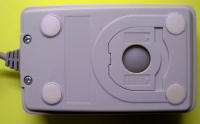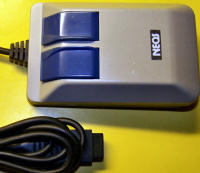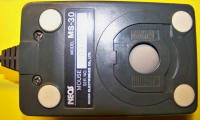- oldmouse blog minis
- trackballs
- tablets & touchpads
- index / miscellanea
- 1960s
- Engelbart's first mouse
- Telefunken "Rollkugel"
- 1966
- Orbit X-Y Ball Tracker
- 1970s
- Mystery wheel mouse
- Hawley Mouse House
- 1972
- Alto I [2]
- 1981
- Xerox 8010 Star [2]
- 1982
- Logitech
- VisiOn GUI
- Mouse Systems
- KoalaPad
- 1983
- Hawley Mark II X063X
- Lisa
- Microsoft
- Microsoft green-eyed mouse
- 1984
- Macintosh
- 1985
- NeXT Computer
- Microsoft grey-eyed mouse
- 1986
- Hawley DEC mouse
- GEOS GUI
- Atari ST mouse
- Commodore 1350 Mouse
- 1987
- IBM PS/2
- Microsoft 'Dove bar' mouse
- 1996
- USB (see: Connectors)
Commodore Mouse
This Commodore 1350 Mouse for the Commodore 128 computer has no labels on the botton.
The 1351 Mouse manual explains:
The Commodore 1351 mouse for use with the C64/C128 product line is a small two-button device which is connected to either of the joystick ports on the C64/C128.
The mouse supports two distinct operation modes:
1) Joystick mode.
2) Proportional mode.
Proportional mode is usable with the C64 or the C128, and requires a special machine language driver to yield optimum performance.
Mode selection is determined when the mouse is powered up. If the user depresses the right mouse button when the device is powered up, then the mouse will be in joystick mode.
If the user does not depress the right mouse button when the device is powered up, then the mouse will default to proportional mode.
Joystick mode allows you to utilise the mouse as a joystick when using software which does not support proportional mode.
... The left mouse button is mapped to what would be the fire button on a joystick.
This Wikipedia article seems to contradict the above manual:
"The Amiga and the Atari ST use an Atari standard DE-9 connector for mice, the same connector that is used for joysticks on the same computers and numerous 8-bit systems, such as the Commodore 64 and the Atari 2600. However, the signals used for mice are different from those used for joysticks. As a result, plugging a mouse into a joystick port causes the "joystick" to continuously move in some direction, even if the mouse stays still, whereas plugging a joystick into a mouse port causes the "mouse" to only be able to move a single pixel in each direction."
Presumably, software tells these mouses know how to behave on Commodore computer's joystick port.
NEOS Mouse
This NEOS Mouse for the Commodore 64/128 came from London.
Label:
NEOS MODEL MS-30 MOUSE SER. NO. 090607 NIHON ELECTRONICS CO., LTD.
The ball housings for these mice look like the ball housing for the Omnimouse by Mouse Systems.
Contriver M-1 & M-2 mouses for the Commodore 





